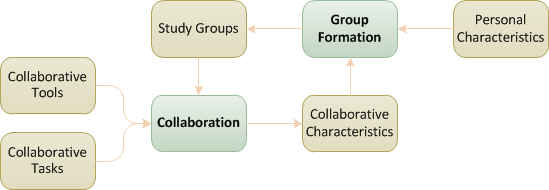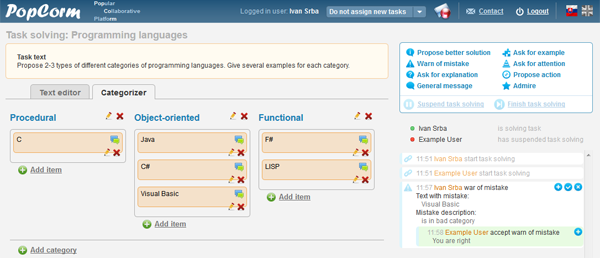|
Encouragement of Collaborative Learning Ivan Srba Master thesis project supervised by prof. Mária Bieliková |
Motivation
Research in Computer-Supported Collaborative Learning (CSCL) can be grouped into systematic and dialogical approaches. The systematic approach concerns creating of models how the specific features of technological systems support or constrain collaboration, reasoning, knowledge representation, and structure of discourse. On the other hand, the dialogical approach considers learning as a social-based activity. Its goal is to provide new concepts how students and teachers collaborate together. In addition, the dialogical approach explores how to design CSCL tools to support effective collaboration.
In our project, we deal with the dialogical approach, especially with encouragement of students in collaborative learning by creating dynamic short-term study groups and design a collaboration platform which allows these groups to collaborate efficiently. The reason to follow this goal is the fact that we do not know what makes collaboration really effective. If we want students to collaborate effectively we need to help students to find appropriate collaborators. Therefore we propose a method for creating dynamic study groups.
Method
The proposed solution consists of two main processes. Group Formation takes different personal or collaborative characteristics as inputs and creates study groups. Personal characteristics can be student’s knowledge, interests, or any other personal characteristics (e.g. age, gender). We can obtain these characteristics from many sources, such as existing user models, social networks or questionnaires. Furthermore, characteristics can be collaborative, such as friendship with other students or student’s collaborative behaviour. Characteristic activities performed during collaborative task solving can be obtained automatically as we propose in the next section. Collaboration allows students of created groups to participate on task solving via prepared collaborative tools integrated into the common collaborative platform.

The basic idea of our solution is derived from Group Technology (GT) approach. According to Selim, et al. Group Technology (GT) is an approach to manufacturing and engineering management that helps manage diversity by capitalizing on underlying similarities in products and activities. One application of the GT approach in manufacturing is a so-called Cellular Manufacturing. Groups of machines should be located in close proximity in order to produce a particular family of similar parts and thus minimize production and transfer time.GT seems to solve similar problem as we have to solve to reach our goal.
Analogy between domain entities can be easily found. It is possible to replace a machine with a student, a part with a characteristic, assignment of parts to the machine with assignment of characteristics to the student, and a family of similar parts with a set of related characteristics. Moreover, we can find this analogy also in goals; instead of optimizing machine production we need to optimize collaboration process.
Implementation of collaborative environment
Evaluation of our method for group formation cannot be accomplished without a collaborative environment where it is applied. Therefore, we have designed and realized the collaboration platform called Popular Collaborative Platform – PopCorm which consists of four collaborative tools which are suitable for task solving in CSCL: a text editor, a graphical editor, a categorizer, and a semi-structured discussion. The categorizer is a special tool developed for solving different types of tasks the solution of which consists of one or more lists (categories). The semi-structured discussion represents a generic communication tool independent of a particular type of a task being solved. It provides 18 different types of messages (e.g. propose better solution). These different message types allow us to automatically identify student’s activities.
Recorded activities are used to measure the collaboration by set of seven dimensions designed rooted in studies in psychology, which includes the following attributes: argumentation and reaching consensus, task and time management, shared task alignment. In addition, pedagogue can manually add the eighth dimension representing quality of created answer.

Evaluation
We performed evaluation of our method and the collaboration platform in two phases. Firstly, we realized in February 2012 a short-term controlled experiment. The purpose of this experiment was to evaluate preconditions of the proposed method; namely, the precondition whether activities form natural clusters (behavioral patterns) which influence collaboration in the positive or on the contrary in the negative way. Moreover, the experiment was also an opportunity to get valuable comments on the implementation of the collaboration platform. Five participants in total took part in the experiment and solved 12 tasks. The precondition was confirmed and our method was able to identify three clusters of students and activities at the end of the experiment with grouping efficacy more than 88%.
The second phase consisted of a long-term experiment which was realized during summer term as a part of education on the course Principles of Software Engineering at the Slovak University of Technology in Bratislava (see Table 1). Students learn new topics and share information during lectures or during their individual study by means of adaptive web-based educational system ALEF with integrated PopCorm platform for solving assignments collaboratively.
Table 1. Statistics of results achieved in the second phase of experiment
| Metric | Value | Additional notes |
| Number of students | 110 | Number of students who are assigned to group at least once. |
| Number of groups | 254 | Additional 35 were created but students were not able to start collaboration. |
| Number of activities | 3763 | Each activity corresponds to one sent message in the semi-structured discussion. |
| Average duration of solution | 11 minutes | Each cluster contains in average 6 characteristics and 11 students. |
The 8-dimensional evaluation of the groups created using our method was compared with a reference method (k-means clustering) and randomly created groups (see Table 2). Groups created by our method achieved the most effective and successful collaboration in comparison with the other two types of groups. We employ ANOVA statistical model to evaluate significance of achieved results and we got p-value 0.0048. Thus, the achieved results can be considered as highly significant. Additionally, students have provided a higher explicit feedback in these groups.
Table 2. Comparison of achieved results during the second phase of the experiment
| Groups created | Average evaluation | Feedback |
| By the proposed method | 0.459 | 4.01 |
| By the reference method (k-means clustering) | 0.392 | 3.55 |
| Randomly | 0.422 | 3.29 |
Publications
- Srba, I.
- Encouragement of Collaborative Learning Based on Dynamic Groups. Master thesis, Slovak University of Technology in Bratislava, May 2012. 63p.
 pdf (in Slovak)
pdf (in Slovak)
- Srba, I.
- Collaboration Support by Groups Creation in Educational Domain. In Information Sciences and Technologies Bulletin of the ACM Slovakia, Vol. 4, No. 2 (2012) 62-64
- Srba, I., Bielikova, M.
- Encouragement of Collaborative Learning Based on Dynamic Groups. In Proc. of EC TEL 2012. Springer. To appear.
| to Homepage | to Teaching | to the Top |
|
||
|
||